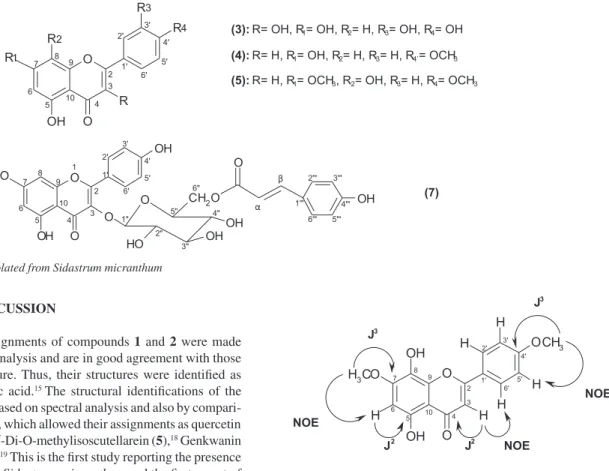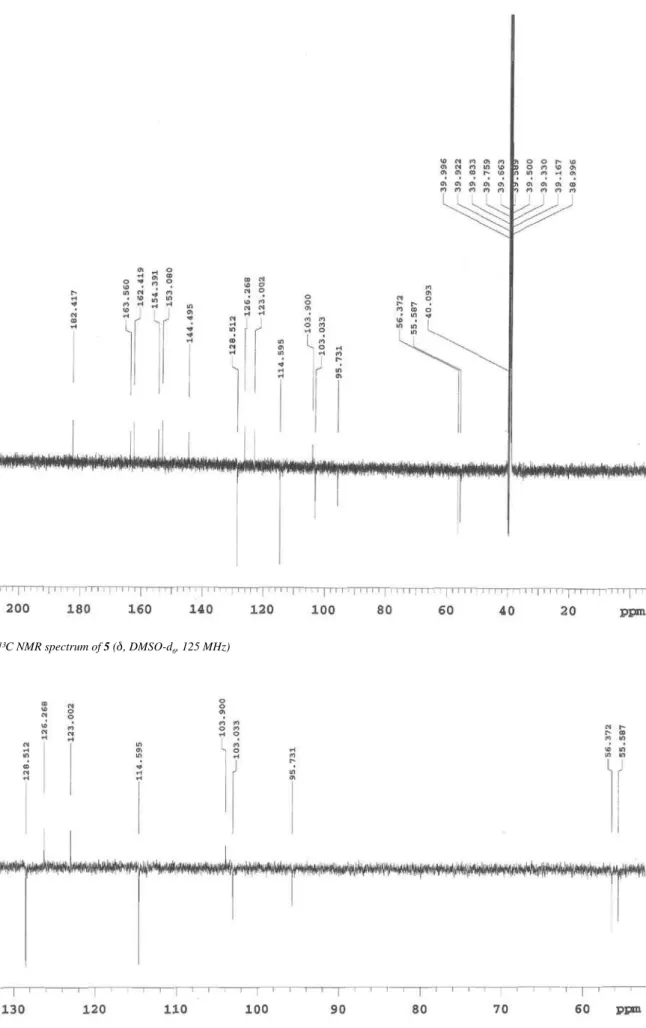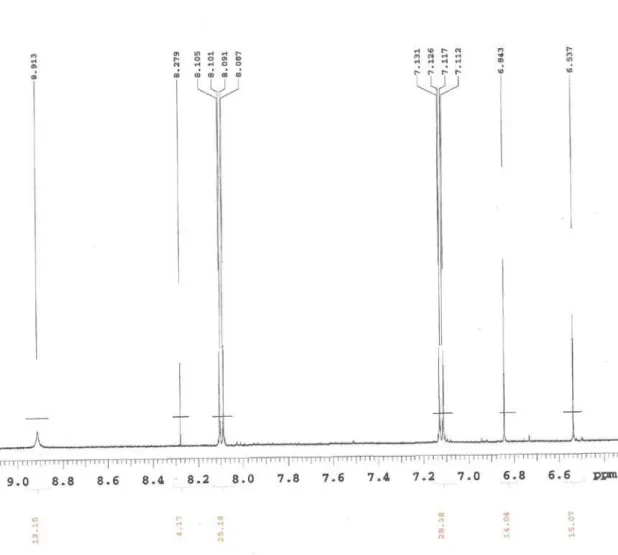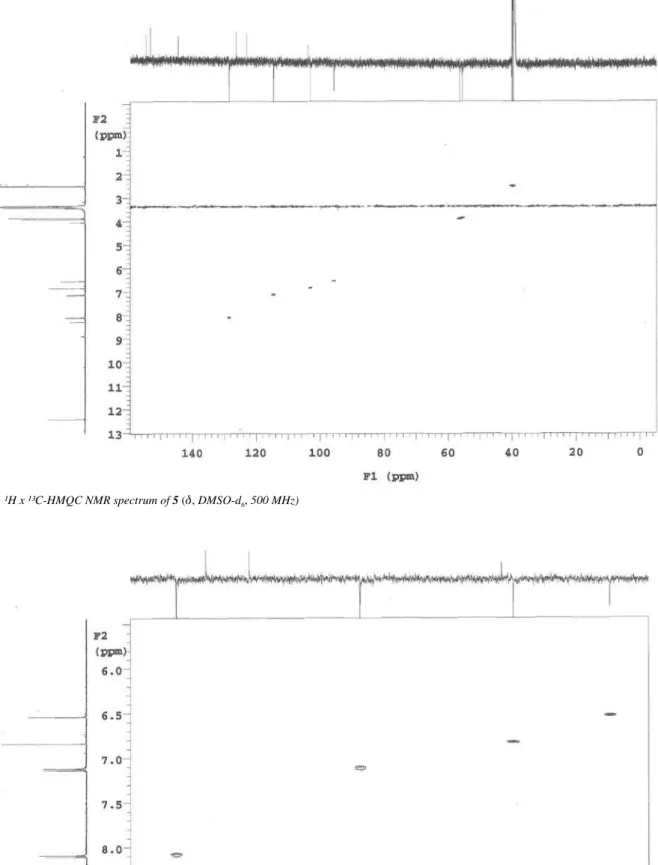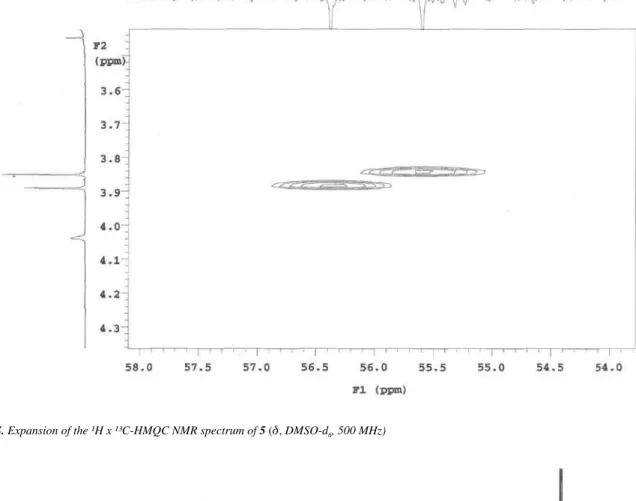Quim. Nova, Vol. 34, No. 8, 1385-1388, 2011
Artigo
*e-mail: mfvanderlei@ltf.ufpb.br
PHENOLIC COMPOUNDS FROM Sidastrum micranthum (A. St.-Hil.) FRYXELL AND EVALUATION OF ACACETIN AND 7,4’-DI-O-METHYLISOSCUTELLAREIN AS MOTULATOR OF BACTERIAL DRUG RESISTENCE
Roosevelt A. Gomes, Rafael R. A. Ramirez, Jéssica Karina da S. Maciel, Maria de Fátima Agra e Maria de Fátima Vanderlei de Souza*
Laboratório de Tecnologia Farmacêutica “Delby Fernandes de Medeiros”, Centro de Ciências da Saúde, Universidade Federal da Paraíba, CP 5009, 58051-970 João Pessoa – PB, Brasil
Vivyanne S. Falcão-Silva e José P. Siqueira-Junior
Departamento de Biologia Molecular, Universidade Federal da Paraíba, CP 5009, 58051-970 João Pessoa – PB, Brasil
Recebido em 13/12/10; aceito em 21/3/11; publicado na web em 5/5/11
From the aerial parts of Sidastrum micranthum (A. St.-Hil.) Fryxell(Malvaceae) were isolated m-methoxy-p-hydroxy-benzaldehyde, o-hydroxy-benzoic acid, acacetin, quercetin, 7,4′-Di-O-methylisoscutellarein, genkwanin and tiliroside. These compounds were identiied by data analyses of spectroscopic methods. Although acacetin and 7,4′-Di-O-methylisoscutellarein did not display relevant antibacterial activity (MIC = 256 μg/mL), they modulated the activity of antibiotics, i.e. in combination with antibiotics at 64 μg/mL (¼ MIC), a two-fold reduction in the MIC was observed for norloxacin and ethidium bromide; regarding tetracycline and erythromycin a two-fold reduction in the MIC was observed only with 7,4′-Di-O-methylisoscutellarein.
Keywords: Sidastrum micranthum; Malvaceae; modulation of drug resistance.
INTRODUCTION
Malvaceae is a widespread family with about 243 genera and 4225 species, particularly distributed in tropical areas.1 Natural products extracted from plants that belong to the Malvaceae family are used in the treatment of many diseases worldwide.2 Some of these uses include snakebites, asthma, diuretic, treatment of rheumatism and gastrointestinal disorders, among others.3
Sidastrum micranthum (A. St.-Hil.) Fryxell, commonly known in Brazil as “malva-preta”, consists of a small shrub belonging to the Malvaceae family. It is a neotropical species, occurring commonly in Cuba, Costa Rica, Venezuela, Guyana and Brazil.4 Furthermore, a nutriceutical (tea or infusion) made from leaves is used traditio-nally against bronchitis, coughs and asthma. The leaves are used in cataplasms, with hot butter and olive oil as a moisturizing agent.5
In recent years, bacterial resistance to antibiotics has become a serious public health problem that concerns almost all antibacterial agents. Eflux pumps are integral proteins of the bacterial membrane and are recognized as a major cause of bacterial resistance since they extract antibiotics from the cell.6
One option for reversing or reducing the eflux-mediated resistan-ce is the development of modulators of drug resistanresistan-ce such as eflux pump inhibitions (EPI), which can potentiate antibiotic activity. Plants provide a rich source of EPIs and several compounds have already been identiied as potent inhibitors.7
In our ongoing project to evaluate natural compounds isolated from plants of the Brazilian biodiversity, mainly of the Malvaceae family, as modulators of antibiotic resistance, we have already demonstrated the modulatory activity of a pentamethoxylavone and of a glycosilated kaempferol derivative (tiliroside) isolated from Herissantia tiubae (K. Schum) Brizicky.8 In the present work, we evaluate the lavonoids
aca-cetin and 7,4′-Di-O-methylisoscutellarein as modulators of antibiotic resistance using efluxing strains of Staphylococcus aureus.
EXPERIMENTAL Instruments and reagents
Melting points were recorded in a Model MQAPF-302 (Micro-quimica Equipamentos Ltda). Isolated compounds were identiied by IR (Perkin-Elmer, FT-IR-1750 and Shimadzu – IR prestige 21) and extensive 1D and 2D NMR analysis (1H 200 MHz, 13C 50 MHz - Varian-Mercury and 1H 500 MHz, 13C 125 MHz - Bruker-AC, COSY, HSQC, HMBC, NOESY) using deuterated chloroform (CDCl3), dimethyl sulfoxide (DMSO-d6) or methanol (CD3OD) as solvents.
Chromatography columns were carried out on silica gel (ASTM, 230-400 mesh, Merck) and Sephadex LH-20 (GE Healthcare Bio-Sciences AB). TLC were performed on silica gel PF254 plates and the spots were visualized under UV light (244 and 366 nm) and by spraying with 5% FeCl3 reagent.
Plant material
The aerial parts of Sidastrum micranthum were collected in June 2006 in the city of Santa Rita at the State of Paraíba, Brazil. A voucher specimen (Agra 6865) is deposited at the Herbarium Prof. Lauro Pires Xavier (JPB), Universidade Federal da Paraíba, Paraíba – Brazil. Extraction and isolation
and posteriorly partitioned with hexane, chloroform, ethyl acetate and n-buthanol, resulting in 46 g of hexane phase, 7 g of chloroform phase, 6 g of ethyl acetate phase and 8 g of n-buthanol phase.
An aliquot of the hexane phase (6 g) was subjected to silica gel column chromatography and eluted with hexane, ethyl acetate and then methanol, gradually increasing the polarity, yielding 239 fractions which were combined after TLC analysis. The sub-fraction 144-151 (0.204 g) was also submitted to chromatography column over silica gel, using hexane, dichloromethane and methanol, resulting in 37 fractions, also combined by TLC. The Sub-fraction 34 led to isolation of compound 1 (8.0 mg).
The chloroformphase (7.0 g)was subjected to iltration under reduced pressure using silica gel 60 as stationary phase into a funnel of porous plate and was eluted with: hexane, ethyl acetate and methanol pure or mixture binaries. The fraction hexane-ethyl acetate (50:50) (0.823 mg) from this procedure was lash chromatographed on silica gel column, eluting with hexane, ethyl acetate and methanol, with increasing polarity to yield 119 sub-fractions. Sub-fraction 10-13 led to isolation of compound 2 (4.5 mg). Fraction ethyl acetate-methanol (50:50) was further puriied by repeated CC on Sephadex LH-20 (MeOH) yielding compound 3 (15 mg).
The ethyl acetate phase (6 g) was subjected to iltration under reduced pressure using silica gel 60 as stationary phase into a funnel of porous plate, being eluted with: hexane/ethyl acetate (30:70), (50:50), (30:70), ethyl acetate, ethyl acetate/methanol (90:10), (70:30) and (50:50), yielding the respective fractions. The fraction hexane/ethyl acetate (50:50) (218 mg) which was puriied after recrystallization using hexane with drops of ethyl acetate led to isolation of compound 4 (42 mg). The fraction hexane/ethyl acetate (30:70) (160 mg) from vacuum liquid chromatography of ethyl acetate phase was submitted to chromatography over lash silica gel, eluting with hexane, ethyl acetate and methanol, yielding 74 fractions. After TLC analysis, frac-tions 45-58 yielded compound 5 (30 mg). Fraction ethyl acetate (1.21 g) from the ethyl acetate phase was subjected to the same previous chromatographic procedure resulting in 100 fractions. Subfractions 09-11 and 66-67 were gathered and then recrystallized with acetone, yielding compound 6 (19 mg) and compound 7 (120 mg) respectively. Quercetin (3,7,3’,4’-tetrahydroxy-lavone) (3)
1H NMR (d, CD
3OD, 500 MHz): 7.72 (d, J = 2.5 Hz, H-2’), 7.61 (dd, J = 8.5 Hz, H-6’), 6.87 (d, J = 8.0 Hz, H-5’), 6.37 (d, J = 2.0 Hz, H-8), 6.17 (d, J = 2.0 Hz, H-6). 13C NMR (125 MHz): 177.3 (C-4), 165.5 (C-7), 162.4 (C-5), 158.2 (C-9), 148.7 (C-4´), 148.0 (C-2), 146.2 (C-3´), 137.2 (C-3), 124.1 (C-1’), 121.6 (C-6’), 116.2 (C-5’), 116.1 (C-2’), 104.5 (C-10), 99.2 (C-6), 99.4 (C-8).
Acacetin (5,7-dihydroxy-4’-methoxy-lavone) (4) 1H NMR (d, CDCl
3 with drops of CD3OD, 500 MHz): 7.72 (d, J = 9.0 Hz, H-2’/6’), 6.89 (d, J = 9.0 Hz, H-3’/5’), 6.43 (s, H-3), 6.32 (d, J = 2 Hz, H-8), 6.15 (d, J = 2.0 Hz, H-6), 3.76 (s, OCH3-4’).
13C NMR (125 MHz): 182.3 (C-4), 164.0 (C-2), 163.9 (C-7), 162.5 (C-4’), 161.4 (C-5), 157.8 (C-9), 127.9 (C-2´/6’), 123.3 (C-1’), 114.3 (C-3’/5’), 104.4 (C-10), 103.6 (C-3), 99.13 (C-6), 94.1 (C-8), 55.3 (OCH3-4’). 7,4′-Di-O-methylisoscutellarein (5,8-dihydroxy-7,4′ -dimethoxy-lavone) (5)
1H NMR (d, DMSO-d
6, 500 MHz): 8.09 (dd, J = 7.0 Hz and J = 2.0 Hz, H-2´/6´), 7.12 (dd, J = 7.0 Hz and J = 2.0 Hz, H-3´/5´), 6.84 (s, H-3), 6.53 (s, H-6), 3.88 (s, OCH3-7), 3.85 (s, OCH3-4´). 13C NMR (125 MHz): 182.4 (C-4), 163.5 (C-2), 162.4 (C-4´), 154.3 (C-7), 153.0 (C-5), 144.4 (C-9), 128.5 (C-2´/6´), 126.2 (C-9), 123.0 (C-1´), 114.5 (C-3´/5´), 103.9 (C-10), 103.0 (C-3), 95.7 (C-6), 56.3 (OCH3-7), 55.6 (OCH3-4´).
Genkwanin (5,4’-dihydroxy-7-methoxy-lavone) (6) 1H NMR (d, DMSO-d
6, 500 MHz): 7.94 (d, J = 9.0 Hz, H-2´/6´), 7.08 (d, J = 9.0 Hz, H-3´/5´), 6.63 (s, H-3), 6.46 (d, J = 2.0 Hz, H-8), 6.21 (d, J = 2.0 Hz, H-6), 3.88 (s, OCH3-7). 13C NMR (125 MHz): 181.9 (C-4), 165.1 (C-7), 164.11 (C-2), 161.3 (C-4´), 161.2 (C-5), 157.2 (C-9), 116.0 (C-3’/5’), 128.5 (C-2’/6’), 121.1 (C-1´), 104.7 (C-10), 103.0 (C-3), 97. 9 (C-6), 92.7 (C-8),56.61 (OCH3-7).
Tiliroside [Kampherol-3-O-β-D-(6’’-E-p-coumaroil) glicosídeo] (7)
1H NMR (d, CD
3OD, 200 MHz): 7.96 (d, J = 9.0 Hz, H-2’/6’), 7.38 (d, J = 15.9 Hz, H-β), 7.25 (d, J = 8.6 Hz, H-2’”/6’”), 6.79 (d, J = 9.0 Hz, H-3’/5’), 6.77 (d, J = 8.6 Hz, H-3’”/5’”), 6.27 (d, J = 2.0 Hz, H-8), 6.11 (d, J = 2.0 Hz, H-6), 6.05 (d, J = 15.9 Hz, H-α), 5.23 (d, J = 7.6 Hz, H-1”), 4.19 (dd, J = 11.8 and 2.2 Hz, H-6”), 4.06 (dd, J = 11,6 and J = 6,4 Hz, H-6”) 3.38-3.34 (m, H-2”, 3”, 4”), 3,25-3,16 (m, H-5”). RMN 13C (50 MHz): 179.3 (C-4), 168.8 (COO), 165.7 (C-7), 162.8 (C-5), 161.4 (C-4’), 161.0 (C-4’”), 159.2 (C-2), 158.2 (C-9), 146.5 β) 135.2 (C-3), 132.1 (CH-2’/CH-6’), 131.1 (CH-2’”/6’”), 127.0 (C-1’”), 122.6 (C-1’), 116.7 (CH-3’”/5’”), 115.9 (CH-3’/5’), 114.7 (CH-α), 105.5 (C-10), 104.0 (CH-1”), 99.9 (CH-6), 94.8 (CH-8), 77.9 (CH-3”), 75.7 (CH-2”, CH-5”), 71.6 (CH-4”), 64.3 (CH2-6”).
Bacterial strains
Three strains of S. aureus were used: SA-1199B, which ove-rexpresses the norA gene encoding the NorA eflux protein which extrudes hydrophilic luorquinolones and other drugs such as DNA-intercalating dyes; 9 RN4220 harboring plasmid pUL5054, which carries the gene encoding the MsrA macrolide eflux protein;10 and IS-58, which possesses the TetK tetracycline eflux protein.11 The strains, kindly provided by Prof. S. Gibbons (University of London), were maintained on blood agar base (Laboratórios Difco Ltda., Brazil) slants and, prior to use, the cells were grown overnight at 37 °C in brain heart infusion broth (BHI – Laboratórios Difco Ltda., Brazil).
Antibiotics, ethidium bromide and lavonoids
Norloxacin, erythromycin, tetracycline and ethidium bromide were obtained from Sigma Aldrich Co. Ltd. The stock solutions of the antibiotics were prepared according to CLSI guidelines,12 and the ethidium bromide in sterile distilled water. The stock solution of acacetin and 7,4’-di-O-methylisoscutellarein were prepared in DMSO, and its highest concentration remaining after dilution into broth (4%) caused no inhibition of bacterial growth.
Drug susceptibility testing and modulation assay
Phenolic compounds from Sidastrum micranthum (A. St.-Hil.) Fryxell 1387 Vol. 34, No. 8
RESULTS AND DISCUSSION
The structural assignments of compounds 1 and 2 were made based on the spectral analysis and are in good agreement with those reported in the literature. Thus, their structures were identiied as Vanillin14 and salicylic acid.15 The structural identiications of the compounds 3-7 were based on spectral analysis and also by compari-son with literature data, which allowed their assignments as quercetin (3),16 acacetin (4),17 7,4′-Di-O-methylisoscutellarein (5),18 Genkwanin (6),17 and tiliroside (7).19 This is the irst study reporting the presence of these compounds in Sidastrum micranthum and the irst report of the compounds 4, 5, and 6 from the Malvaceae family.
The IR spectrum of compound 5 showed a hydroxyl signal at 3458 cm-1, a conjugated carbonyl hydroxyl absorbance at 1665 cm-1 and aromatic C=C stretching absorptions at 1609 and 1510 cm-1. The 1H NMR spectra showed a pair of double doublets at d
H 8.09 (J = 7.0 Hz and J = 2.0 Hz) and dH 7.12 (J = 7.0 Hz and J = 2.0 Hz), which suggests an AA’BB’-type system of hydrogens bonded to aromatic carbon. A methoxyl group in one of the aromatic nuclei was inferred by the signal at dH 3.88.
The 13C NMR spectral data strengthened the information provided by the 1H NMR spectra, emphasizing the presence of the AA’BB’ system due to signal at dC 128.5 and dC 114.5.
The positions of methoxyl groups were established by HMBC spectrum, which showed interactions between the absorptions at dH 3.85 (s, OCH3-4´) and dC 162.4 (C-4´). In addition to interactions between the absorptions at dH 3.88 (s, OCH3-7) dC 154.3 (C-7). Trough the analysis of NOESY spectrum was possible to strengthen the posi-tions of methoxyl groups by correlaposi-tions between the absorpposi-tions dH 3.88 (s, OCH3-7) and dH 6.53 (s, H-6). In addition to the interactions between absorptions at dH 3.85 (s, OCH3-4´) and dH 7.12 (d, J = 9.0 Hz, H-3´/5´). Some others assignments for the two-dimensional spectra (HMBC and NOESY) are shown in Figure 2.
The combination of spectral analysis of IR spectroscopy, 1H and 13C nuclear magnetic resonance, with aid of two dimensional techniques, and by the comparisons with literature data, have ratiied the structure 5 as being 7,4′-di-O-methylisoscutellarein, lavonoid unpublished in the Malvaceae family.
Modulation of antibiotic activity
Acacetin and 7,4′-Di-O-methylisoscutellarein showed no anti-bacterial activity at 256 μg/mL against any strains of S. aureus used. When the compounds were incorporated into the growing medium at 64 μg/mL (¼ MIC), a two-fold reduction in the MIC was observed
for norloxacin and ethidium bromide. Regarding tetracycline and erythromycin a two-fold reduction in the MIC was observed only with 7,4′-Di-O-methylisoscutellarein. All experiments were carried out at least twice with similar results (Table 1).
The lavonoids modulated activities of the antibiotics by reducing the concentration of antibiotics needed to inhibit the growth of the drug resistant eflluxing bacteria. At least regarding tetracycline and erythromycin, 7,4′-Di-O-methylisoscutellarein can be favorably compared with acacetin, which may be related to its higher lipophi-licity due to an additional methoxyl group at C-7, since lipophilipophi-licity is a common feature of several EPIs and may be a key factor for the inhibition in Gram-positive bacteria.13 Ethidium bromide is a well known substrate for NorA eflux protein, and active eflux is the only Table 1. Minimum inhibitory concentrations (MICs) of antibiotics and ethidium bromide in the absence and presence of acacetin or 7,4′ -Di-O-methylisoscutellarein against efluxing strains of Staphylococcus aureus strain
Strain (drug) MIC (μg/mL)
Alone + ACA
(64 µg/mL)
+ DMIS (64 µg/mL)
1199B (norloxacin) 64 32 (2)a 32 (2)
1199B (ethidium bromide) 32 16 (2) 16 (2)
IS-58 (tetracycline) 32 32(0) 16 (2)
RN-4220 (erythromycin) 256 256 (0) 128 (2)
ACA, acacetin; DMIS, 7,4′-Di-O-methylisoscutellarein. a (fold reduction
in MIC). Figure 1. Compounds isolated from Sidastrum micranthum
known mechanism of resistance to this DNA-intercalating dyes.20 Therefore, the use of ethidium bromide against the strain SA-1199B is of worth to demonstrate that the lavonoids evaluated in this case modulated the resistance to norloxacin by inhibition of eflux pump.
Some methoxylated flavones that potentiate the activity of antimicrobial drugs have been described.21 However, as far as we know, neither acacetin nor 7,4′-Di-O-methylisoscutellarein had been previously evaluated. The present inding indicates that plants of the Malvaceae family could be useful as a source of potential adjuvant of antibiotics.
SUPPLEMENTARY MATERIAL
Available at http://quimicanova.sbq.org.br, in PDF ile, with free access.
ACKNOWLEDGMENTS
J. P. Siqueira-Junior and V. S. Falcão-Silva are very grateful to Dr. S. Gibbons (University of London) for his valuable and kind co-operation. Appreciation is extended to V. C. O. Costa/LMCA-UFPB and to CENAUREN-UFC for the acquisition of NMR spectra. This work was supported by the following Brazilian agencies: CNPq, CAPES and FAPESQ-PB.
REFERENCES
1. Costa, D. A.; Silva, D. A.; Cavalcanti, A. C.; Medeiros, M. A. A.; Lima, J. T.; Cavalcante, J. M. S.; Silva, B. A.; Agra, M. F.; Souza, M. F. V.; Quim. Nova 2007, 30, 901.
2. Maganha, E. G.; Halmenschlager, R. C.; Rosa, R. M.; Henriques, J. A. P.; Ramos, A. L. K. P.; Safi, J.; Food Chem. 2009, 118, 1.
3. Darwish, F. M. M.; Reinecke, M. G.; Phytochemistry 2003, 62, 1179; Silva, D. A.; Chaves, M. C. O.; Costa, D. A.; Moraes, M. R. R.; Nóbrega, F. B. P.; Souza, M. F. V; Pharm. Biol. 2005, 43, 197; Franzotti, E. M.; Santos, C. V. F.; Rodrigues, H. M. S. L.; Mourão, R. H. V.; Andrade, M. R.; Antoniolli, A. R. J.; J. Ethnopharmacol. 2000, 72, 273. 4. Bovini, M. G.; Carvalho-Okano, R. M.; Vieira, M. F.;Rodriguésia 2001,
52, 17.
5. Agra, M. F.; Baracho, G. S.; Basílio, I. J. D.; Nurit, K.; Coelho, V. P.; Barbosa, D. A.; Oecol. Bras. 2007, 11, 323.
6. Webber, M. A.; Piddock, L. J. V.; J. Antimicrobrob. Chemother. 2003, 51, 9; Piddock, L. J. V.; Clin. Microbiol. Rev. 2006, 19, 382.
7. Gibbons, S.; Phytochem. Rev. 2005, 4, 63; Gibbons, S.; Planta Med. 2008, 74, 597.
8. Silva, D. A.; Falcão-Silva, V. S.; Gomes, A. Y. S.; Costa, D. A.; Lemos, V. S.; Agra, M. A.; Braz-Filho, R.; Siqueira-Júnior, J. P.; Souza, M. F. V.; Pharm. Biol. 2009, 47, 128; Falcão-Silva, V. S.; Silva, D. A.; Souza, M. F. V.; Siqueira-Junior, J. P.; Phytother. Res. 2009, 23, 1367. 9. Kaatz, G. W.; Seo, S. M.; Ruble, C. A.; Antimicrob. Agents Chemother.
1993, 37, 1086; Kaatz, G. W.; Seo, S. M.; Antimicrob. Agents Che-mother. 1995, 39, 2650.
10. Ross, J. I.; Farrell, A. M.; Eady, E. A.; Cove, J. H.; Cunliffe, W. J.; J. Antimicrob. Chemother. 1989, 24, 851.
11. Gibbons, S.; Udo, E. E.; Phytother. Res. 2000, 14, 139.
12. CLSI – Clinical and Laboratory Standards Institute/NCCLS; Perfor-mance Standards for Antimicrobial Susceptibility Testing; Fifteenth Informational Supplement, CLSI/NCCLS document M100-S15, Clinical and Laboratory Standards Institute: Wayne, 2005.
13. Stavri, M.; Piddock, L. J. V.; Gibbons, S.; J. Antimicrob. Chemother. 2007, 59, 1247.
14. Tenailleau, E.; Lancelin, P.; Robins, R. J.; Akoka, S.; Anal. Chem. 2004, 76, 3818.
15. Tomaz, A. C. A., Nogueira, R. B. S. S., Pinto, D. S., Agra, M. F. Souza, M. F. V.; Cunha. E. V. L., Braz. J. Pharmacogn. 2008, 18, 47. 16. Luo, W.; Zhao, M.; Yang, B.; Shen, G.; Rao, G.; Food Chem. 2009, 114,
499.
17. Park, Y.; Moon, B.; Yang, H.; Lee, Y.; Lim, Y.; Magn. Reson. Chem. 2007, 45, 1072.
18. Horie, T.; Ohtsuru, Y.; Shibata, K.; Yamashita, K.; Tsukawama, M.; Kawamura, Y.; Phytochemistry 1998, 47, 865.
19. Cavalcante, J. M. S.; Nogueira, T. B. S. S.; Tomaz, A. C. A.; Silva, D. A.; Agra, M. F.; Carvalho, P. R. C.; Ramos, S. R. R.; Nascimento, S. C.; Gonçalves-Silva, T.; Souza, M. F. V.; Quim. Nova 2010, 33, 846. 20. Markham, P. H.; Westhaus, E.; Klyachko, K.; Johnson, M. E.; Neyfakh,
A. A.; Antimicrob. Agents Chemother. 1999, 43, 2404.
Quim. Nova, Vol. 34, No. 8, S1-S10, 2011
Supplementary Material
*e-mail: mfvanderlei@ltf.ufpb.br
PHENOLIC COMPOUNDS FROM Sidastrum micranthum (A. St.-Hil.) FRYXELL AND EVALUATION OF ACACETIN AND 7,4’-DI-O-METHYLISOSCUTELLAREIN AS MOTULATOR OF BACTERIAL DRUG RESISTENCE
Roosevelt A. Gomes, Rafael R. A. Ramirez, Jéssica Karina da S. Maciel, Maria de Fátima Agra e Maria de Fátima Vanderlei de Souza*
Laboratório de Tecnologia Farmacêutica “Delby Fernandes de Medeiros”, Centro de Ciências da Saúde, Universidade Federal da Paraíba, CP 5009, 58051-970 João Pessoa – PB, Brasil
Vivyanne S. Falcão-Silva e José P. Siqueira-Junior
Departamento de Biologia Molecular, Universidade Federal da Paraíba, CP 5009, 58051-970 João Pessoa – PB, Brasil
Figure 2S.¹³C NMR spectrum of 5 (d, DMSO-d6, 125 MHz)
Phenolic compounds from Sidastrum micranthum (A. St.-Hil.) Fryxell 3
Vol. 34, No. 8
Figure 4S.Expansion of the ¹³C NMR spectrum of 5 (d, DMSO-d6, 125 MHz)
Phenolic compounds from Sidastrum micranthum (A. St.-Hil.) Fryxell 5
Vol. 34, No. 8
Figure 8S. ¹H x ¹³C-HMQC NMR spectrum of 5(d, DMSO-d6, 500 MHz)
Phenolic compounds from Sidastrum micranthum (A. St.-Hil.) Fryxell 7
Vol. 34, No. 8
Figure 10S.Expansion of the ¹H x ¹³C-HMQC NMR spectrum of 5(d, DMSO-d6, 500 MHz)
Figure 12S. Expansion of the ¹H x ¹³C-HMBC NMR spectrum of 5(d, DMSO-d6, 500 MHz)
Phenolic compounds from Sidastrum micranthum (A. St.-Hil.) Fryxell 9
Vol. 34, No. 8
Figure 14S.Expansion of the ¹H x ¹H-NOESY NMR spectrum of 5(d, DMSO-d6, 500 MHz)
